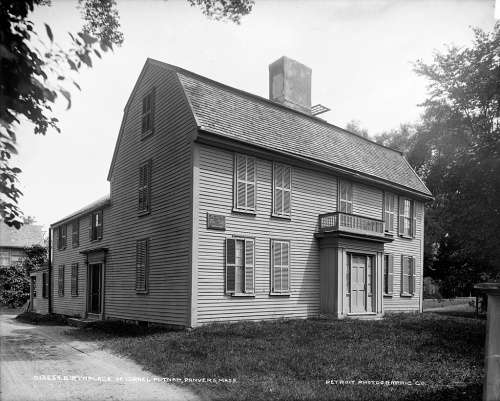Gen. Israel Putnam famously left his plow in the ground when he heard about the Battles of Lexington and Concord and immediately rode the 100 miles from his farm in Brooklyn, Conn., to Cambridge. That plow became something of a local attraction. Years earlier, he created another local attraction, one still around today: The Israel Putnam Wolf Den.

Israel Putnam
Known as Old Put, he was one of the most interesting and vigorous characters of the American Revolution. A reckless fighter, he survived a shipwreck in Cuba, galloped down a rocky cliff to escape the British and risked his life to save a burning powder magazine. During the French and Indian War he served as a Rogers’ Ranger. Mohawk Indians captured him and came close to burning him alive until it rained and a French officer intervened.
The Israel Putnam Wolf Den
Israel Putnam was born on Jan. 7, 1718 in what is now Danvers, Mass. His birthplace still stands, now owned by his descendants.

Israel Putnam birthplace
At 22, he then moved to Pomfret, Conn., attracted by the town’s cheap land for sale.
According to legend, Israel Putnam killed Connecticut’s last wolf in Pomfret two years after he arrived.
Putnam had a substantial home by then, cleared fields and a flock of sheep. But a she-wolf kept attacking his and his neighbors’ flocks. Finally, Putnam and his neighbors got together and decided to pursue the wolf until she was dead.
They spotted her one winter night and followed her to a stream six miles away. Then she turned and entered a cave. The men set up a guard, gathered a crowd of men and boys with guns and dogs and lit a fire at the mouth of the cave.
Hours passed and the wolf remained inside. Finally, Israel Putnam persuaded his neighbors to let him go into the cave with a torch. They tied a rope around his ankle and prepared to pull him out when he kicked.

Israel Putnam Wolf Den
Dead Wolf, Live Farmer
The den’s narrow passageway sloped down fifteen feet, then ran horizontally about 10 feet more and rose gradually 16 feet. Putnam crawled into the cave – you couldn’t stand up in it — and saw the she-wolf’s eyeballs three yards away from him. He kicked the rope, and was dragged out so quickly he lost his shirt.
Putnam then crawled back into the cave with a gun and shot the wolf. His neighbors dragged him out again, nearly overcome by smoke. He revived and crawled back into the cave a third time, where he found the dead wolf, seized her by the ears and kicked the rope. The dead wolf and the live young farmer were dragged out together.
The story was told many times during Putnam’s military career.

Gen. Israel Putnam escapes British dragoons, another of his famous exploits
Putnam’s Wolf Den is on the National Register of Historic Places, and can be found in Mashamoquet Brook State Park.
At the turn of the 20th century, author Clifton Johnson visited Old Put’s old stomping grounds in Pomfret. In his 1915 book Highways & Byways of New England, Johnson tells of visiting the Wolf Den and of meeting an old New Englander.
“We had that plough of Putnam’s on exhibition here once,” said the old man. “And by gosh! When I saw it I didn’t blame Putnam for leaving it in the field. It was nothing but a crooked stick shod with iron, and I’ll be darned if I’d put it in the barn if it was mine.”
Images: Israel Putnam Wolf den By Ehkastning – Own work, CC BY-SA 3.0, https://commons.wikimedia.org/w/index.php?curid=35801371. Cartoon image of wolf https://creativecommons.org/publicdomain/zero/1.0/.
This story last updated in 2024.

6 comments
Not bad looking for 296!
His ride was even more remarkable — he first rode to Lebanon, CT to meet with Gov. Trumbull at the War Office, before returning to Brooklyn and heading to Cambridge — by modern roads, that would be about 150 miles.
That would be an exceptional amount of horse back riding for a 57 year old man in the course of 24 hours or so today!
Putnam’s ride is not, however, unique. The much younger Henry Knox rode at a similar pace to Ticonderoga, though it took him far, far longer to return with the cannons he took custody of there.
I also must believe there was some sort of relay of horses, or horses readily for hire at taverns — 150 miles in 24 hours would’ve exceeded expectations for top-notch cavalry mounts in the Civil War which was near the height of horse-powered warfare, and often with better roads — the Revolutionary era was before turnpikes and plank or corduroy roads would have been common I’ve never seen this discussed in history books of the Revolution before.
[…] as 'Old Put,' Israel was one of the most interesting and vigorous characters of the American Revolution. One of Connecticut’s Sons of Liberty, he was a reckless fighter who […]
[…] militia, but insisted on fighting as a private in the thick of the fighting. He asked Gen. Israel Putnam where the heaviest fighting would […]
[…] showed up the next day and asked Gen. Israel Putnam where the heaviest fighting would be. Commissioned a major general in the Massachusetts militia, […]
[…] Turns out its an Eastern Coyote or Coywolf (though I do believe the Grey Wolf has returned to Connecticut, regardless of the legend of Putnam). […]
Comments are closed.